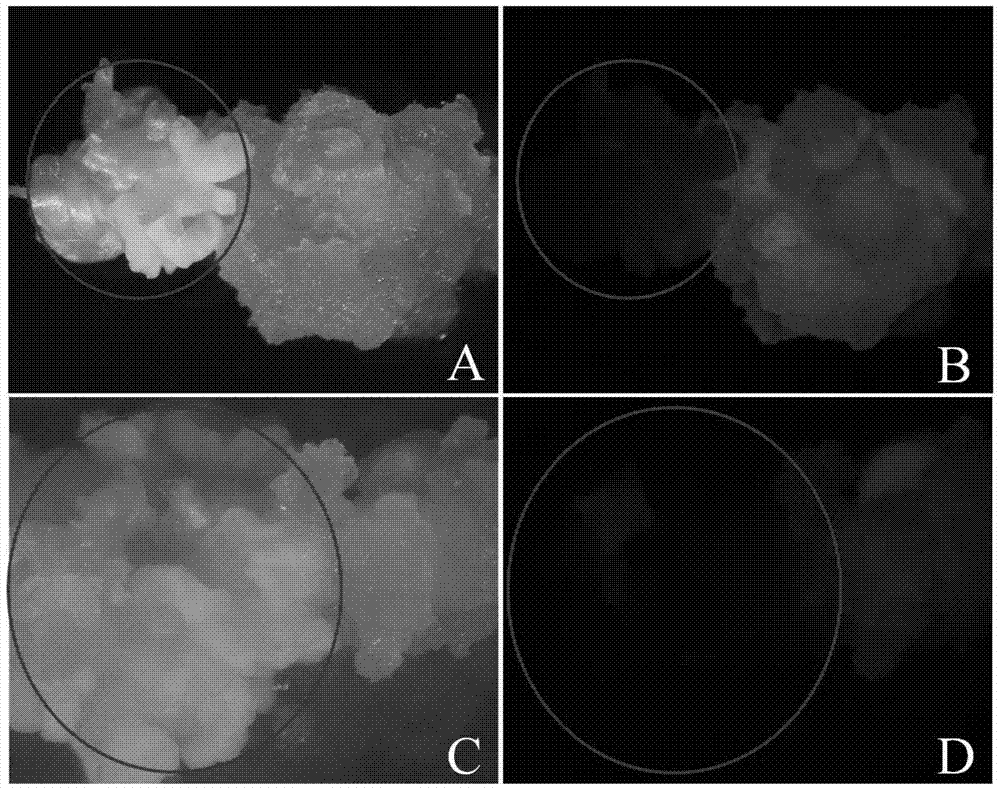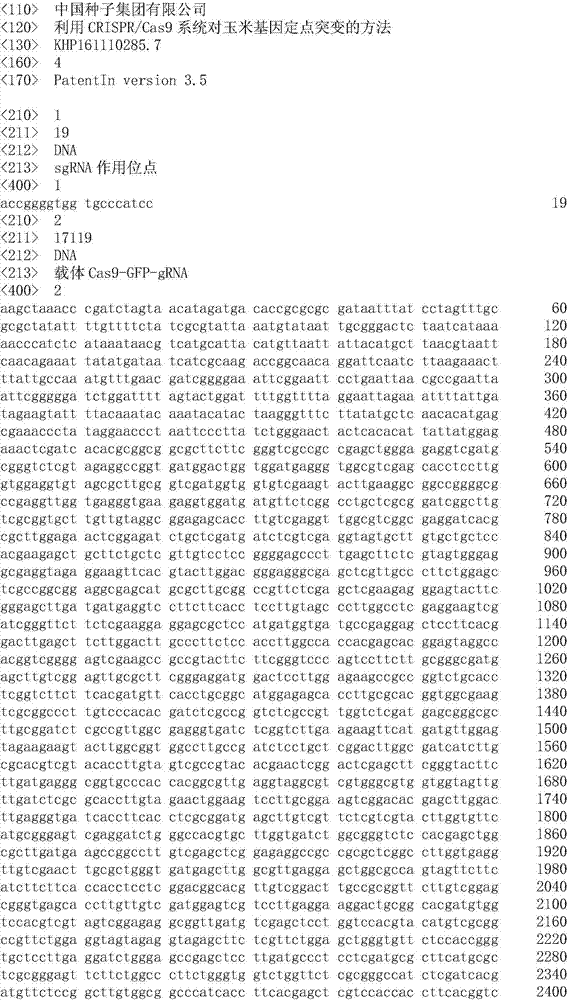Method for site-directed mutation of maize gene by means of CRISPR/Cas9 system
A gene site-directed mutagenesis, cas9-gfp-gRNA technology, applied in genetic engineering, botany equipment and methods, biochemical equipment and methods, etc.
- Summary
- Abstract
- Description
- Claims
- Application Information
AI Technical Summary
Problems solved by technology
Method used
Image
Examples
Embodiment 1
[0037] Example 1 Construction of a CRISPR / Cas9 system targeting the GFP gene in the Maize Xiang 249 inbred line
[0038] 1. Design the sgRNA sequence based on CRISPR / Cas9 for the GFP gene in the maize Xiang 249 inbred line. Wherein, the nucleotide sequence of the sgRNA action site is 5'-ACCGGGGTGGTGCCCATCC-3'.
[0039] 2. Ligate the DNA fragment containing the sequence encoding the sgRNA into a vector carrying CRISPR / Cas to construct the vector Cas9-GFP-gRNA for transforming maize. Wherein, the full sequence of the carrier Cas9-GFP-gRNA is shown in SEQ ID NO:2.
Embodiment 2
[0040] Example 2 Preparation method of gene site-directed mutation maize plant
[0041] 1. Treatment of corn ears and separation of immature embryos
[0042] (1) Maize Xiang 249 inbred line T1 generation transgenic maize plants carrying exogenous GFP gene were planted in the greenhouse. About 10 days after pollination, when the immature embryos grew to 0.8-2.0 mm, corn cobs were harvested, bracts were removed, and prepared sterilization;
[0043] (2) Dilute the sodium hypochlorite mother solution with a concentration of 6-15% to 15%-20% by volume with sterilized water, add Tween-20% by 1 drop (20μL) / 3L and mix to make a sterilized solution;
[0044] (3) Put the cobs of corn into the sterilizing solution and soak for 15 minutes, rinse with sterile water 3-5 times for later use;
[0045] (4) Peel off the top of the seeds with a sterile scalpel blade, dig out the endosperm with a sterile spatula to expose the immature embryos from the seeds, and strip the immature embryos. Pla...
Embodiment 3
[0067] Example 3 Detection of gene site-directed mutation maize
[0068] 1. Observation on the expression of GFP gene in site-directed mutation maize tissue
[0069] Take the resistant callus after site-directed mutation of the GFP gene in Example 2, observe the expression of the GFP gene in the callus, and find that green fluorescence is seen under ultraviolet light, indicating that the GFP gene in this part of the callus has not been targeted Mutation, if there is no green fluorescence under ultraviolet light, it means that the GFP gene has been inactivated, and the results are shown in figure 1 . From figure 1 It can be seen that the two newly born glyphosate-resistant calli have no expression of GFP, but the non-resistant callus has GFP expression ( figure 1 B, D). It shows that the GFP gene is normally expressed in the untransformed cells, but the GFP gene is no longer expressed in the transformed cells, indicating that the GFP gene has been successfully edited and in...
PUM
 Login to View More
Login to View More Abstract
Description
Claims
Application Information
 Login to View More
Login to View More - R&D
- Intellectual Property
- Life Sciences
- Materials
- Tech Scout
- Unparalleled Data Quality
- Higher Quality Content
- 60% Fewer Hallucinations
Browse by: Latest US Patents, China's latest patents, Technical Efficacy Thesaurus, Application Domain, Technology Topic, Popular Technical Reports.
© 2025 PatSnap. All rights reserved.Legal|Privacy policy|Modern Slavery Act Transparency Statement|Sitemap|About US| Contact US: help@patsnap.com



